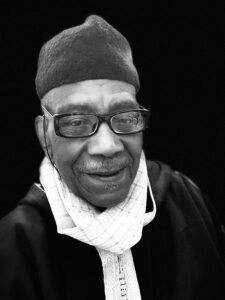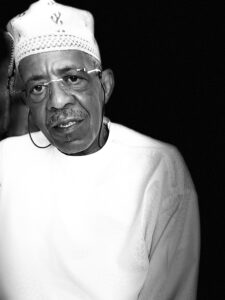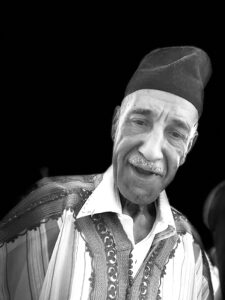Gnaoua music holds a profound significance in Moroccan and African cultures. It is an ancient and spiritual art form that has been passed down through generations, encapsulating the wisdom, rituals, and traditions of our ancestors.
However, in today’s fast-paced and ever-changing world, there is an urgent need to safeguard and promote the original rituals and traditions associated with Gnaoua music.

Story of Maalem Ahmed Bakbou
I have grown up in a large Gnaoua family, where we were immersed in the rituals from a young age. At 12 years old, I started feeling the urge to begin my career.
Being raised in the realm of Gnaoua, surrounded by various Malams and belonging to a sizable household and extended family of Gnawis, we learned from one another and offered mutual support.
Preserving the music and cultural heritage of the Gnaoua Gimbri is of utmost importance. Throughout our journey, we have experienced different eras and encountered diverse individuals. While the rituals were truly authentic in the past, they have undergone changes in recent times.
We want the younger generation to comprehend that our aim is not to alter but to maintain the originality. While we may incorporate additions or modifications, we strive to preserve the essence of the original rituals and pass them on to future generations.

Story of Maalem Mustapha Bakbou
I embarked on developing my career at a young age. My mentor and teacher in Gnaoua music, specifically the Gimbre, is Malam Ahmad Bakbou. I learned to play the Qarqaba from my father and the Gimbri from Malam Ahmed.
In the past, playing the Gimbri held great sanctity. I didn’t perform in front of others, but rather learned in secret. I never revealed my Gimbri-playing abilities and kept them hidden even from my older brother.
This was because, in the past, it was highly regarded and respected. The Maalem held a distinguished title and possessed unique skills. Playing the Gimbri was not a simple endeavor.

Story of Maalem Abderkbir Merchan
During my childhood, I used to attend school, but whenever there was a lila ceremony, I would skip school to witness it.
This was because of my deep passion for Gnaoua music. During our time, we had elaborate processes and various rituals. The lila ceremonies spanned seven nights, and we made extensive preparations.
Each night had its own special rituals. Unfortunately, nowadays these rituals are on the verge of disappearing, as the ceremonies have been reduced to just one night, and even the Maalems (masters) are dwindling in number. Only three or four prominent names remain.
We earnestly hope that the current generation will embrace this flame of tradition and devote themselves to preserving and passing it on to the next generation, just as we have done.

Story of Maalem Hicham Merchan
We perform the Lila ceremony with the intention of helping people who may be unwell. We visit the house of Makadma and bring along a camel and a goat. We invoke the Arabic concept of Baraka, combining it with Gnaoua music, singing, dancing, and enjoying a festive atmosphere. The Lila, to me, represents a series of rituals that are an ancient heritage of Moroccan-African culture.
The Lila involves numerous rituals, serving as a means to connect people, spirits, and jins with the spiritual realm. It encompasses various processes, starting from the initial invitation to the spirits, to rituals like Nkshaf, Tahr-e-Haba, Al-Bambra, and many more.
In the past, the Lila spanned seven nights, each night holding its significance. On the first night, the ladies of the house, the girls of Makadma, would gather, clean the space, wash clothes, and prepare food. Meanwhile, the Gnaoua musicians would be playing their instruments. Nowadays, these cultural traditions are becoming increasingly rare. It is challenging to find people who continue these rituals, with only a few individuals like Nafbayush still practicing them. Those who were once dedicated to this field are mostly no longer with us.
We need to consider ways to preserve these rituals from fading away entirely. The significance of the seven colors and associated rituals originates from their symbolic representation of elements from nature and the world. For instance, white represents peace, and red symbolizes blood. Just like walking into a garden reveals a variety of colors, each color in the rituals holds its own symbolic meaning.
The rituals involved in entering a trance state hold a profound spiritual essence. They address various aspects, providing an avenue for individuals to release negative energy from their souls or minds. When someone dances to the music played by the maalem, the maalem can distinguish between those who are possessed by spirits and those who are merely releasing negative energy and embracing positive energy. This is essentially what the trance state encompasses.

Story of Maalem Mohamed Amin
To me, Gnaoua music holds deep spiritual significance. It serves as a powerful storytelling medium, recounting the trials and tribulations of the past, including the era of slavery and the range of emotions experienced during those times—madness, sadness, joy, and happiness.
Within Gnaoua music, there exists a rich repertoire of songs, each carrying its own essence and narrating a unique story. We sing about virtuous individuals and explore themes related to religion, such as Allah and the Prophet, which align with the Islamic faith.
Gnaoua music has a distinct Sufi and soulful quality. As we observe its evolution among the younger generation, it becomes crucial to remind them of the importance of preserving its originality. This heritage holds immense significance, and we wish them the best of luck in safeguarding this precious flame of culture and tradition, passed down to us from our ancestors, fathers and grandfathers.

Story of Maalem Najib Oubelkas
For me, Gnawa transcends mere music. The Gnawa and Lila of the past were not the same as what we experience today. Changes have occurred, and those who have passed away in the past have left this heritage for our generation. However, despite these changes, it is crucial for us to return to its original essence.
Entering into a trance state is an uncontrollable experience for those who are grappling with inner turmoil in their soul, mind, or body. They are drawn to witness the atmosphere of the lila, and inevitably find themselves dancing and succumbing to the trance. It also provides solace for individuals facing various life problems. When they immerse themselves in the ambiance of the lila, they find a sense of peace, as the music holds a profound spiritual quality.
We consistently emphasize the spirituality of the music, as it guides individuals into those transformative moments of trance. It allows them to momentarily forget everything else, focus intently, and synchronize with the rhythm of the music. It is a transmission that draws people into the realm of Gnaoua music, urging them to respect it and preserve its originality for those who wish to partake in its flame.
For the sake of future generations, it is of utmost importance that they uphold and carry forward the legacy of our predecessors, following in their footsteps and preserving the virtuosity of this art form in its true form.

Story of Maalem Youness Hadir
We believe that Gnaoua music has a profound impact on those who simply hear the sound of the Gimbri and other instruments associated with Gnaoua. It deeply resonates with individuals and captures their attention. This is the secret behind its global influence. Engaging in a trance state through this music has a transformative effect on people, regardless of their background, skin color, or religion.
It touches them on a personal level, and although they may not fully comprehend the meaning of Gnaoua or the lyrics of the songs, they can feel a connection and are moved by the music.
The rituals of the seven colors, in my opinion, are interconnected with our world. Each color symbolizes something that has psychological and environmental significance. This forms the foundation of the seven-color rituals in our music.
Personally, I have a preference for the green color and the corresponding rituals and songs that deeply resonate with me. I feel a strong connection and a sense of well-being when experiencing these songs and rituals.
The Lila is a trance-filled night that has long been a part of the rituals practiced by African slaves. It also holds great importance in Moroccan culture due to its connection to African heritage. In the past, the Lila spanned seven nights, not just one, and each night involved an elaborate preparation process leading up to the grand event.
Every night of the Lila featured distinct rituals. The first night, in the past, involved the gathering of women who would prepare the food, arrange the carpets, and attend to other necessary arrangements. The second night, known as the Vita, involved the mkadma gathering all the colors, covers, and incenses for the Lila, ensuring that the spiritual rituals were properly conducted. Subsequent nights included steps such as sacrifice and the oulad bambra. The final ceremony was the Laada, which marked the conclusion of the gathering.
However, in modern times, we have observed that many of these rituals have been condensed into a single night, and certain elements have been omitted. This is what we are lacking today. It is crucial for us to reflect on and reclaim the originality of Gnaoua music and return to the traditions handed down to us by our ancestors. Preserving it as it is and passing it on to the next generation is of paramount importance.

Story of Maalem Hind Ennaira
For me, the Lila is a night that brings people together, regardless of age, neighbors, family, or friends.
The Lila has its own unique rituals. In the past, it used to be quite extensive, spanning seven nights, with each night featuring different processes. For me, the Lila is like a psychological healing session, akin to visiting a doctor. When you participate in the Lila, it’s an opportunity to release negative vibes, thoughts, and any other negativity that resides within you. The impact of the Lila depends on which song or color resonates with you.
It’s not just those who dance or go into trance that experience healing or release from negative energies during the Lila. Even the maalem, koyos, and everyone present in the ceremony immerse themselves in a deeply spiritual atmosphere created by the rituals, music, vibrations, and rhythm. It’s a process that enables you to enter a trance-like state, shedding negative thoughts and even enhancing positive emotions. The Lila originated during slavery times when people used this music as a means of self-expression, having endured great hardships. It is a music that is spiritually and naturally created.
The qarqaba, made from handcuffs, symbolizes the chains of slavery, while the gimbri, shaped like a boat, represents the vessel they traveled in. Every aspect of the instrument is derived from nature and the earth.
The rituals also have a natural symbolism, such as the seven colors representing the earth and the world around us. I want to convey a message to the younger generation that we have a challenging and significant task ahead of us, which is to preserve this cultural flame and pass it on to the next generation, just as we received it from our ancestors. It is a tremendous responsibility.
We must strive to maintain the originality of this heritage, recognizing that it is not an easy feat. While advancements in technology and the passage of time may make things easier, we must remain focused on how we obtained this heritage in the first place and ensure that it continues to be carried forward in the same manner to future generations, integrating it into their lives.

Story of Maalem Mehdi Qamoum
Gnaoua music has the power to heal people energetically, and we use this music to facilitate healing. Each color carries its own energy, and we provide people with the color that aligns with their needs, helping to open their chakras and promote healing. This is what Gnaoua music means to me—it gives me energy and heals me, allowing me to then share that energy with others. There is an energetic exchange between me and the instrument as I play, and we transmit that energy to those who need healing for their bodies and souls.
For me, the purpose of the Lila is to engage in rituals. It is a sacred practice for individuals who require healing for their bodies or souls, addressing their energy imbalances. During the Lila, when a person enters a trance state, they do so unconsciously, driven by the energy within their soul that seeks out the song that resonates with their specific energy and works to restore harmony, expelling negative energies in the process.
Gnaoua music operates on a system of colors, as each color carries its own unique energy. For example, if someone needs the energy associated with the color red, we would play a song called “LHOMER” to provide them with that energy. This is what the Lila represents to me.
Spiritually, in Morocco, we refer to it as “Jitba.” Jitba is necessary to connect with the energy and capture your energy. We incorporate color into this process by placing a colored object on the head. Additionally, we use incense to help capture and channel this energy. The choice of incense is specific to the color being worked with, as it serves as a cleansing agent.
Before engaging in the Lila, we cleanse the space using “Jawi” or “Salamiya” to rid it of negative energy. Once the space is cleansed, we begin with the white color, which serves a particular purpose. Each color has its own significance and aids in capturing specific energies. It’s similar to meditation, where various elements are required to connect with oneself and bring forth the desired energy. In Gnaoua, we cleanse the space and gather the necessary objects associated with each color.
During the Lila, we play music representing all seven colors throughout the night. Some mkadem specialize in performing Lila ceremonies for a specific color, such as green or yellow, catering to those seeking the energy of that particular color. However, during the Lila, we play music representing all colors to share and distribute the energy among everyone present. This is what makes Gnaoua music spiritual—it resembles a meditative practice.
We make a conscious effort to gather the required objects and cleanse the space, aligning ourselves with the energy of each color. We incorporate elements such as outfits and food choices, with specific colors corresponding to specific items. For example, the color yellow may require the presence of honey and gold accessories, such as bracelets, rings, and perfumes. By incorporating all these elements into the room, we capture the energy associated with the desired color. Each color has its specific objects and rituals to channel its energy.
This is our mission—to harness this energy through Gnaoua music and offer it to those in need, providing healing and assistance. We are here with you, ready to support and heal you.

Story of Maalem Tayeb Dahbi
I believe that Gnaoua has the ability to touch people, regardless of who they are. To truly learn this music, one must experience it through different maalems and masters. This is the secret—you need to gather a wealth of experiences from various sources in order to acquire the knowledge and understanding that will guide you in your ongoing learning journey.
The rituals of Gnawa, in the past, differed from what they are today. To me, rituals hold a more spiritual meaning and serve as a connection to the spirits that exist alongside us. Lila, one of the reasons for these rituals, aims to heal individuals who have been unintentionally or purposely affected or possessed by these spirits. The rituals are designed to address the specific areas in need of healing, establishing a connection between our world and the spirit world.
Gnawa is more than just music or performances—it’s a series of rituals. Going into a trance state is an uncontrolled and indescribable experience. When a person hears Gnaoua music during the Lila ceremony, they enter a trance state unconsciously. They become engrossed in the music and move with the rhythm. At a certain point, the music touches them, and they feel compelled to stand, dance, and release everything negative that resides within them.
The dance is more than just movement—it becomes a trance. The individual dances unconsciously, purging themselves of all negative thoughts and emotions. The rituals involving the seven colors symbolize the world around us. There are various ways to connect and communicate with the spirits, and it is important for me to be protected during the procession of the Lila ceremony, especially when individuals who have been possessed seek healing. I ensure I am spiritually cleansed before the ceremony begins, reciting select verses from the Quran. This protection allows me to fully engage in the Lila, knowing what is happening around me due to my intuitive sense, which I have possessed since a young age. It is crucial to shield oneself from the spiritual realm.
As I inherit this cultural heritage, particularly the music of Gnaoua, I recognize that the present differs from our time in the past. Traditionally, one had to follow a specific process to learn the music. Nowadays, things have changed as learning has become faster and technology plays a role. However, it is essential to preserve the purity of our sources and ensure that the originality of this music is passed down to future generations. If we only focus on the basics and neglect certain aspects, they will gradually disappear over time. Therefore, it is my wish that everyone involved in the transmission of this music to future generations upholds its original essence.
I am grateful to my family for raising me well and providing me with the experiences that have shaped who I am today. I also want to express my gratitude to everyone else, including the host, for their support and appreciation. Thank you.